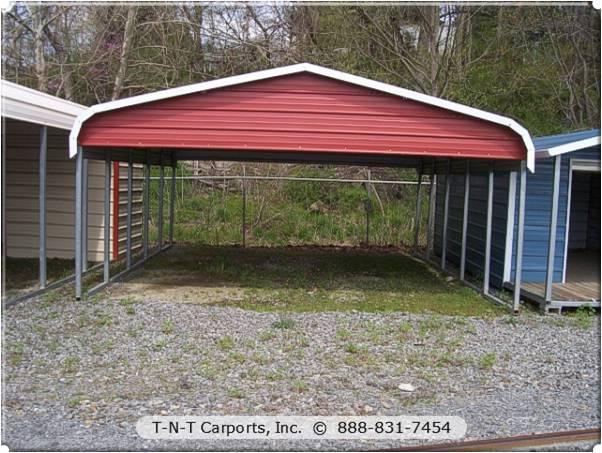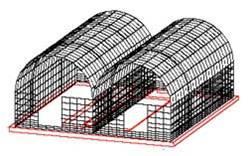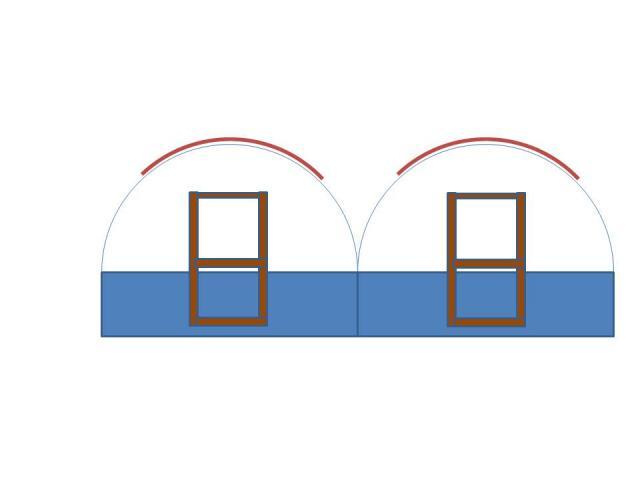Looking for inputs on summer 2011 objective for my long-term breeding project with American and Missouri dominiques. I am in process of designing a barn and coop setup for my farmlet. Whole setup to be on concrete pad to deny burrowing predators and to facilitate cleaning. Barn component is to be covered by an aluminum garage while coops are to be largely livestock panels (4 x 16 with 2 x 4 cells) reinforced by treated 4 x 4 post in corners and 4 intervals along walls. Want structure to resist 100 mph wind. Images used were best approximations I could find on internet.
Barn to contain light tractor, implements , feed storage, brooder room and me when hiding from wife. Feed storage and brooder rooms each to be about 7.5 square feet. Tractor and implement storage to be 8 x 16 feet. Brooder and feed storage rooms will be built under garage roof. See Figure 1.
Figure 1. Garage Roof.

Coops to hold high value large fowl hens. High value in that time will be invested in their productivity during their second and third years as adults. Want to ensure hens suitable for extended productive life before they are used as brood stock to replace themselves with hens. Hens are to be divided between two coops of equal capacity (128 square feet each) such that each will contain between 28 and 32 hens at maximum. Two coops ensure against catastrophic loss to predators. See Figure 2. Coops.
Figure 2. Coops.

My greatest environmental concern is heat during summer. Protection of coops from direct sun 1000 to 1400 will be provided a partial roof. Ventilation will be maximal with minimal restriction as provided by 2 x 4 cell livestock panels. Winter protection will be from direct N wind and from excessive direct exposure to precipitation. During periods of extreme wind chill a flat surface with straw will enable huddling for heat conservation.
Vertical (lower) portion of coop walls to be single panel width 4. Four panels will be arched over wall walls of each coop forming a 16 tunnel with ceiling center roughly 8 above ground. Roost will be suspended at 6.5 so I can walk under yet easily reach up to handle birds at night. Access will be though south facing door into each coop. Egg collection setup still under consideration since will be likely to incorporate either nesting traps or webcams if technology / pocketbook allows. During evaluation phase, hens will be tracked for egg laying performance.
Barn to contain light tractor, implements , feed storage, brooder room and me when hiding from wife. Feed storage and brooder rooms each to be about 7.5 square feet. Tractor and implement storage to be 8 x 16 feet. Brooder and feed storage rooms will be built under garage roof. See Figure 1.
Figure 1. Garage Roof.

Coops to hold high value large fowl hens. High value in that time will be invested in their productivity during their second and third years as adults. Want to ensure hens suitable for extended productive life before they are used as brood stock to replace themselves with hens. Hens are to be divided between two coops of equal capacity (128 square feet each) such that each will contain between 28 and 32 hens at maximum. Two coops ensure against catastrophic loss to predators. See Figure 2. Coops.
Figure 2. Coops.

My greatest environmental concern is heat during summer. Protection of coops from direct sun 1000 to 1400 will be provided a partial roof. Ventilation will be maximal with minimal restriction as provided by 2 x 4 cell livestock panels. Winter protection will be from direct N wind and from excessive direct exposure to precipitation. During periods of extreme wind chill a flat surface with straw will enable huddling for heat conservation.
Vertical (lower) portion of coop walls to be single panel width 4. Four panels will be arched over wall walls of each coop forming a 16 tunnel with ceiling center roughly 8 above ground. Roost will be suspended at 6.5 so I can walk under yet easily reach up to handle birds at night. Access will be though south facing door into each coop. Egg collection setup still under consideration since will be likely to incorporate either nesting traps or webcams if technology / pocketbook allows. During evaluation phase, hens will be tracked for egg laying performance.



